Posted: April 21st, 2015 | Author: Nathan | Filed under: field recording
I’m in the Mojave National Preserve. Massively underrated location, more Joshua trees per acre than Joshua Tree National Park. Gorgeous. Quiet.
My girlfriend is photographing wildflowers in a shallow roadside arroyo. The road follows a set of train tracks; there are small bridges over each arroyo, wash, and ditch. I’m a little bored.
I hear a distant train.
“Where the hell is my field recorder?!?!”
I rummage through the back seat of our car, packed with disorganized camping gear. I violently toss out three huge bags to get at the small Pelican case that holds my Sony PCM-D50. The train gets closer.
I switch on up the D50: No power. “F#&%!!!” I dump the dead batteries into the desert sand, slam fresh batteries in. I toss the Pelican case in the sand and sprint to the small concrete bridge over the arroyo. I slate the take as I run. The train is now visible and almost at the bridge, arriving from my right. I’m rolling. I’m ready…or so I think, having never recorded a train close up before.
The train has two locomotives at the front: They absolutely overload the mics and kick in the D50’s horrendously useless limiters. “S#!%!!!”
But then the cars start rolling by, at least 30dB less loud than the engines. I’m taken aback by the loudness difference and the relative quiet of the cars’ wheels. I’m only 18″ away from the rails; the center of the wheels are at my eye level, elevated above the wash I’m standing in. The old freight cars make a solid chack-chack-chack rhythm, sometimes a galloping sound like a 12-legged horse. The modern liquid container cars produce a smooth, buttery whoosh as they pass. The final engine passes by, screaming like a spacecraft in a sci-fi movie.
I think, for a moment, that I will have no photo to accompany this sound on my blog. Then I do my absolutely ugliest, uncoordinated happy dance, seen only by the ravens and the bees.
[soundcloud url=”https://api.soundcloud.com/tracks/200341399″ params=”color=ff5500&auto_play=false&hide_related=false&show_comments=true&show_user=true&show_reposts=false” width=”100%” height=”166″ iframe=”true” /]
Tags: desert, field recording, industrial, machine, sound effects, vehicle | No Comments »
Posted: April 10th, 2014 | Author: Nathan | Filed under: field recording

The MV Uchuck III, passenger vessel and freigher on the west coast of Vancouver island. Kayak for scale.
One of the many reasons this site experienced an almost 1-year hiatus was a self-supported 2-week kayak expedition (check out the video of this amazing trip) on the northwest coast of Vancouver Island. The island is so riddled with deep networks of inlets that it’s actually quite hard to actually get to the exposed west coast. So, at the tiny logging town of Gold River, BC, we put our kayaks on the MV Uchuck III to get motored out to the coast.
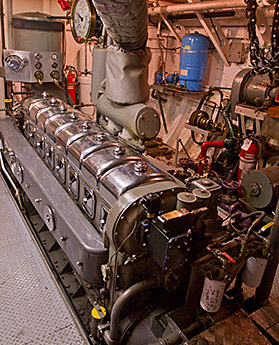
The MV Uchuck III engine room, starboard engine.
The Uchuck III is a lifeline for those that live on the edge of the world, where no roads exist and all travel must be by boat. The Uchuck III brings mail, deliveries, empty dumpsters, groceries, supplies, fish farm provisions, passengers and kayakers from Gold River out to Kyuquot, where we started our trip. It plays a vital role in this extremely remote region, and many generations of skippers and engineers have plied this route. The boat is so storied that there’s even a book about it and its predecessors.
The Uchuck III is a heavily modified World War II minesweeper. The inner double hull and stabilizers were removed to make room for a cargo hold, a crane was added, and the pilot house was moved astern. Its two propellers are powered by one straight-eight diesel engine apiece (a more cranky and surly version of the MV Tutoko, which I rode and recorded in the inlets of New Zealand’s Fiordland), and the skipper can’t control the engines from the pilot house: An actual telegraph is used to relay coded bell rings to the engineer below to take certain actions and “shift gears.” When this thing breaks down, parts need to be machined in Vancouver, from the original construction plans kept aboard.
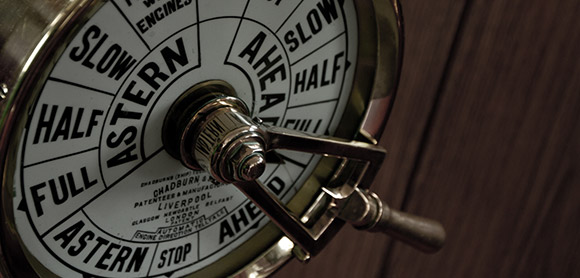
The engine telegraph unit.
Because we were just passing through, essentially, I didn’t get a chance to record too much material, but this post contains some of the perspectives I captured of the ship’s engines and cargo crane. Being a kayak expedition, I only had room for my Sony PCM-D50 recorder, which sucked for nature recording while kayaking…but it was more than sufficient for the loud pounding of the Uchuck III’s twin diesel engines.
[soundcloud url=”https://api.soundcloud.com/tracks/140290347″ params=”color=ff5500&auto_play=false&hide_related=false&show_artwork=false” width=”100%” height=”166″ iframe=”true” /]
Tags: engine, field recording, industrial, machine, mechanical, vehicle, water | 2 Comments »
Posted: October 31st, 2012 | Author: Nathan | Filed under: field recording, sound design
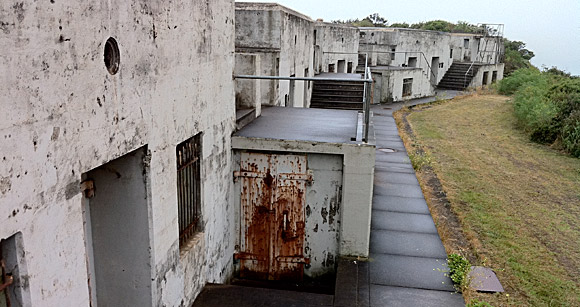
Battery Yates, Fort Baker, Sausalito, California.
Over a year ago, I posted some scraping metal sounds from the steel doors of Fort Baker’s Battery Yates, right at the Golden Gate of the San Francisco Bay. I recently unearthed some metal hits from that same session: They’re heavy, resonant, and the concrete rooms behind them certainly lent the sound some nice air in the low end. (Read the previous installment if you want to learn more about this location and how it was recorded.)
And, since today is Halloween, the original sounds are presented in both their original form and pitched down by an octave for extra heaviness and spookcreeptacularness.
Enjoy the clanky, boomy fun…and happy Halloween!
[soundcloud url=”http://api.soundcloud.com/tracks/65535342″ params=”auto_play=false&show_artwork=false&color=ee0000″ width=”100%” height=”166″ iframe=”true” /]
[MKH 50 microphone into Sound Devices 702]
Tags: creepy, field recording, industrial, metal, resonance, San Francisco, sound effects | No Comments »
Posted: August 2nd, 2011 | Author: Nathan | Filed under: field recording, sound design
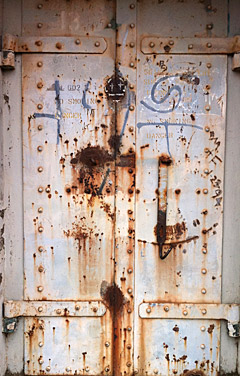
Rusty? Heavy? Covered in graffiti? You KNOW it will sound good.
Many people are unaware that the San Francisco Bay Area was once thoroughly fortified against attacks from the sea. Remnants of this past dot the entrance to the Golden Gate, in the form of bunkers that once housed gun emplacements.
One such installation was Battery Yates at Fort Baker. Located at the best vantage point for southward-facing photos of the Golden Gate Bridge, Battery Yates was meant for nothing other than picking off minesweepers that might try to get through the minefields inside the ‘Gate in wartime…minesweepers, of course, that would never come.
Battery Yates was active from 1905 through 1946. Now, only the U.S. Coast Guard maintains a station at Fort Baker, primarily for saving the lives of boaters and wind/kitesurfers. Now Battery Yates is a tourist attraction, is fun to scramble on and around…and, in swords to ploughshares style, is also a great source for cool sounds!
Each of the gun emplacements has four lockers, each sealed with a massive steel door. Some doors have outer latches that have been left to swing freely in favor of just welding the doors shut. These latches, rusted by more than 60 years of salty mist, are quite expressive when swung, manipulated, and otherwise mishandled. The perfectly square concrete rooms behind these doors caused them to have a lot of low end and resonance.
I decided to try my luck with recording some groaning metal effects on these doors, despite the fact that:
- I only had some time before work one weekday, which meant that…
- I could only record during rush hour, made worse by the fact that…
- The Golden Gate Bridge is only 1/8 of a mile away, plainly visible from the recording site.
All this meant lots of background traffic noise. I mitigated these risks by using a hypercardioid microphone for off-axis rejection of sound (a shotgun would have been a better choice in terms of pattern, but I just loved the sound of my MKH-50 too much to not use it), careful placement of the mic relative to the bridge (making sure that either the mic element faced away from the bridge or a thick concrete wall blocked line of sight), and the judicious use of the Denoiser plugin from iZotope RX. And, for effects like these, the small-condenser-mic proximity effect only helps!
The result came out pretty well, all things considered…although the editing in today’s post is pretty sloppy, so apologies for that. Everything was recorded at 24-bit, 192-kHz, as best befits complex groaning metal sounds, since pitching this stuff down can yield pure sound-design gold. I recorded even more massive metal hits from this session, which may be a topic for a separate post… (And until then, you can hear yet more heavy metal hits/impacts here, here, and here.)
[soundcloud url=”http://api.soundcloud.com/tracks/20003445″ params=”show_comments=true&auto_play=false&color=ee0000″ width=”100%” height=”81″ ]
[MKH 50 microphone into Sound Devices 702]
Tags: field recording, groaning, industrial, metal, noise reduction, resonance, San Francisco, sound design, sound effects, urban | 4 Comments »
Posted: May 12th, 2011 | Author: Nathan | Filed under: field recording, found sound objects, sound design
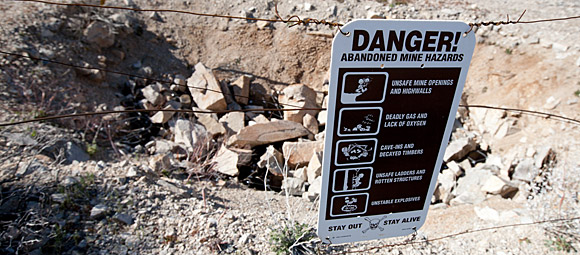
Eton Mine, Lucky Boy Trail, Joshua Tree National Park, California, USA.
[One in a series of posts from my spring 2011 trip to the southern California desert.]
Joshua Tree National Park is beautiful, but much of its history (prior to being designated a National Park) has scarred and pockmarked its landscape. In the Gold Rush, the Joshua Tree hinterlands held some of the most productive mines in California until well into the 1900’s. These mines were big, sprawling, and deep. To my knowledge, no Balrogs were released as a result. But that would explain a lot about Golden State politics.
We hiked on some lesser-traveled trails and found an acre of land with no fewer than five vertical holes in the ground: Mine shafts. They were all wired off and had metal grates over them. One in particular, the Eton Mine on the Lucky Boy trail, had warning signs on the wire fence surrounding it.
It was quite windy that day, and I just knew I had to get the creaking, squeaking sounds of this battered sign on the rusty wire. It took me a surprisingly long time to figure out how to protect my handheld recorder from the wind, but ultimately I decided to use my body as a shield and then stick it under my microfleece hoody. (I had the OEM fuzzy windscreen on it, which is one of the most useless strips of fabric I’ve ever seen, er, heard.) I just hoped that my body protected it from the 25+ mph wind gusts and that the fabric wouldn’t dampen the high frequencies too badly…and because of the sound, I had high-frequency content to burn.
With some judicious noise reduction in post – subtle, as always, gives the best result – it didn’t come out too shabby, considering the horrible recording conditions and super-no-budget wind blocking techniques!
[soundcloud url=”http://api.soundcloud.com/tracks/15163504″ params=”show_comments=true&auto_play=false&color=ee0000″ width=”100%” height=”81″ ]
[Sony PCM-D50 recorder, capsules at 120°]
Tags: creepy, desert, digital audio, eerie, field recording, found object, industrial, joshua tree, metal, resonance, sound design, sound effects, travel | 1 Comment »
Posted: May 4th, 2011 | Author: Nathan | Filed under: field recording, found sound objects, sound design

"Ol' Wheezy" the Water Spigot, as we called him, at our campground in the desert.
[One in a series of posts from my spring 2011 trip to the southern California desert.]
Joshua Tree National Park is in the Mojave Desert. It’s dry. Only two campgrounds in the entire park have running water of any kind. Bad weather on the coast of California caused us to decide to stay in the desert at the tail end of a week’s vacation, so we were lucky to just show up at Joshua Tree and grab a spot at one of these prime campgrounds.
I camp a lot, all over the place, but I had never seen a water spigot quite like the one near our site. It was like the wet dream of a post-apocalytpic film production designer: Big, industrial, heavy, and red. If a common water pump could be bad ass, this one could.
Anyway, the draw-up of water sounded really neat, so I whipped out the ol’ handheld recorder and took some samples on our last morning there. It reminded me a bit of the sound of EVE coming out of her landing ship’s tube from the film WALL•E.
In developed campgrounds, you need to be up really early to avoid noise from fellow campers. No wonder I like backpacking so much…
[soundcloud url=”http://api.soundcloud.com/tracks/13996448″ params=”show_comments=true&auto_play=false&color=ee0000″ width=”100%” height=”81″ ]
[Sony PCM-D50 recorder, capsules at 120°]
Tags: desert, digital audio, field recording, industrial, joshua tree, machine, sound design, sound effects, travel, whoosh | 6 Comments »
Posted: January 20th, 2011 | Author: Nathan | Filed under: found sound objects, sound design

Mr. Heater, the oddest and loudest camping stove ever.
One of the guys at work loves camping gadgets (as do I), and he shared a video of his odd little Mr. Heater camp stove making some weird unholy racket. Naturally, I asked to borrow it and did some recording sessions with it over the holidays.
A metal reflector lets the unit be used as either a heater or a camp stove. This ring of steel doesn’t make much sound when it’s running (all you hear is the hiss of gas emission, much like this recording), but it sure resonates when the stove fires up, starting as one tone and diverging into two separate tones, creating a harmony. Very effective or driving away bears, or as a means for summoning the dead.
The only processing applied to this sound is some noise reduction to minimize the gas regulator’s hiss, to pull the resonance forward. Recorded at 192kHz, a clip like this is ripe for pitch shifting for even scarier tones! (Mic placement was tricky; placing the mics right in front would melt them instantly.)
[soundcloud url=”http://api.soundcloud.com/tracks/9154382″ params=”show_comments=true&auto_play=false&color=ee0000″ width=”100%” height=”81″ ]
[Sennheiser MKH 50/30 pair, rigged for mid-side stereo, into a Sound Devices 702 recorder]
Tags: field recording, industrial, metal, resonance, sci-fi, sound design, sound effects | 5 Comments »
Posted: December 20th, 2010 | Author: Nathan | Filed under: found sound objects, sound design
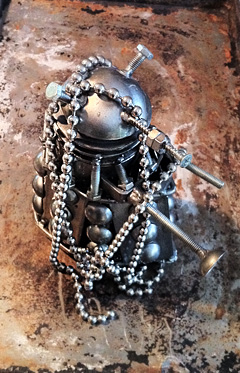
Exterminate! Exterminate!
In North America, the end of the Western calendar year brings Thanksgiving, Hanukkah, Kwanza, Christmas…lots of holidays, most of which revolve around eating. In our household, that means one thing above all else: PIE SEASON.
My wife loves making pies and tarts, and one of the baker’s secret weapons for such endeavors are pie weights. They’re simply large, heavy versions of the more common metal-ball-style keychain. Ours is about four feet in length.
While washing dishes after a piemaking bonanza, I noticed the sound it made as I dragged it over the lip of our stainless steel sink. Finally, on a rainy winter day, I decided to do some recording and processing.
I grabbed three things for this session: The pie weights, a really beat-up baking sheet, and a small model of a Dalek made from spare parts (a gift from a dear friend). I simply moved the pie weights across each of these objects in different ways. Hot metal-on-metal action!
The balls on the pie weights made a great ratcheting sound that instantly made me think of a castle portcullis being raised and lowered, or a ship’s winch retracting an anchor. Of course, the size of these weights made pretty bright sounds, but that’s what pitch shifting is for…
So, today’s sound is a mix of these sounds, some raw, and some pitched down significantly. I didn’t do anything besides pitch shifting and EQ, just to show how flexible these high-frequency, detailed sounds can be when recorded at 192kHz. These sounds were recorded with a large-diaphragm condenser mic, because I found that proximity effect from close-miking with a small-diaphragm condenser produced too much bass to provide the balanced, bright sounds that I was going after.
[soundcloud url=”http://api.soundcloud.com/tracks/8225412″ params=”show_comments=true&auto_play=false&color=ff7700″ width=”100%” height=”81″ ]
[Røde NT1a microphone into Sound Devices 702 recorder]
Tags: dalek, digital audio, field recording, industrial, machine, metal, pie, sound design, sound effects | 5 Comments »
Posted: October 28th, 2010 | Author: Nathan | Filed under: field recording, found sound objects

Beer, toiletries, ice chest, field recorders. Yep, that's a well-stocked camping trip!
The metal bearproof food locker is a common sight in the developed campgrounds of the Sierra Nevada mountains. They’re infamously noisy to open, close, and move things around in, and are usually the first sounds you hear in the morning. They do their job, though…provided you have them closed. I once had a close encounter with a bear whose head was stuck right into my slightly open bear locker (in my defense, it was in the midst of dinner preparation), but that’s another story for another blog.
I finally decided to record one on a trip this summer. It was a kayaking trip, so I had both my Zoom H2 [yeah, this is an older sound] and a hydrophone, so I decided to use both: The Zoom would get the stereo effects and the hydrophone would pick up the raw vibrations. I placed the H2 horizontally centered in the locker, and placed the hydrophone on the single shelf inside. Holy resonance, Batman!
Today’s sound is a collection of hits from this outdoors session, made with hands, metal objects, and a rubber mallet, first at normal pitch and then an octave lower. It wound up mixing rather well with my collection of shovel-in-wheelbarrow sounds from a while back. Get those subwoofers ready for the second half…
[soundcloud url=”http://api.soundcloud.com/tracks/6510828″ params=”show_comments=true&auto_play=false&color=ee0000″ width=”100%” height=”81″ ]
[Zoom H2 (120° capsule spread), Aquarian Audio H2a-XLR hydrophone into Sound Devices 702 recorder]
Tags: digital audio, field recording, found object, industrial, metal, microphone, percussion, sound design, sound effects | 8 Comments »
Posted: July 30th, 2010 | Author: Nathan | Filed under: found sound objects, sound design

Brrrrwwwwaaaawwwrrrrrwwwaaar!
This might be harder to find at a thrift store than at an electronics or hobby store, but there are a large number of ultra-small toy helicopters on the market that can be had for not a lot of dosh. They’re flimsy. They don’t fly well. But they do scare the hell out of family pets, which instantly makes them entertaining, and they do make pretty cool sounds.
So, imagine this: You’re only one person with no assistants nearby. These helicopters, well, they fly erratically. How do you keep a mic trained on it to get a good recording? I solved this problem before by putting wireless mics on moving objects, but they’re far to heavy for something like this. Well, let’s just take advantage of the toy’s weak flying ability: Why not just hold the stupid thing while the rotors rotate? The rotors, however, rotate really quickly, and move a surprising amount of air. The body of the helicopter is so teensy that I couldn’t find a good mic position that blocked the air being moved around, which of course creates a lot of distortion and rumble.
Rather than futz around with a bulky windscreen and furry windjammer, I decided to just attach a contact microphone to the helicopter with gaffer’s tape. This worked reasonably well, especially after a quick equalization adjustment to overcome the somewhat dull midrange response of the mic itself. The sound that was transmitted through the high-density foam body was actually more interesting and full than the rotor’s sound in the free air, anyway. Besides the aforementioned EQ pass, this recording is unaltered. Recorded at 192kHz, this could provide all manner of mechanical effects if pitched down or processed further!
[soundcloud url=”http://soundcloud.com/noisejockey/toy-helicopter” params=”show_comments=true&auto_play=false&color=dd0000″ width=”100%” height=”81″ ]
[Contact microphone into Sound Devices 702 recorder]
Tags: digital audio, found object, helicopter, industrial, machine, sound design, sound effects, toy | 4 Comments »










